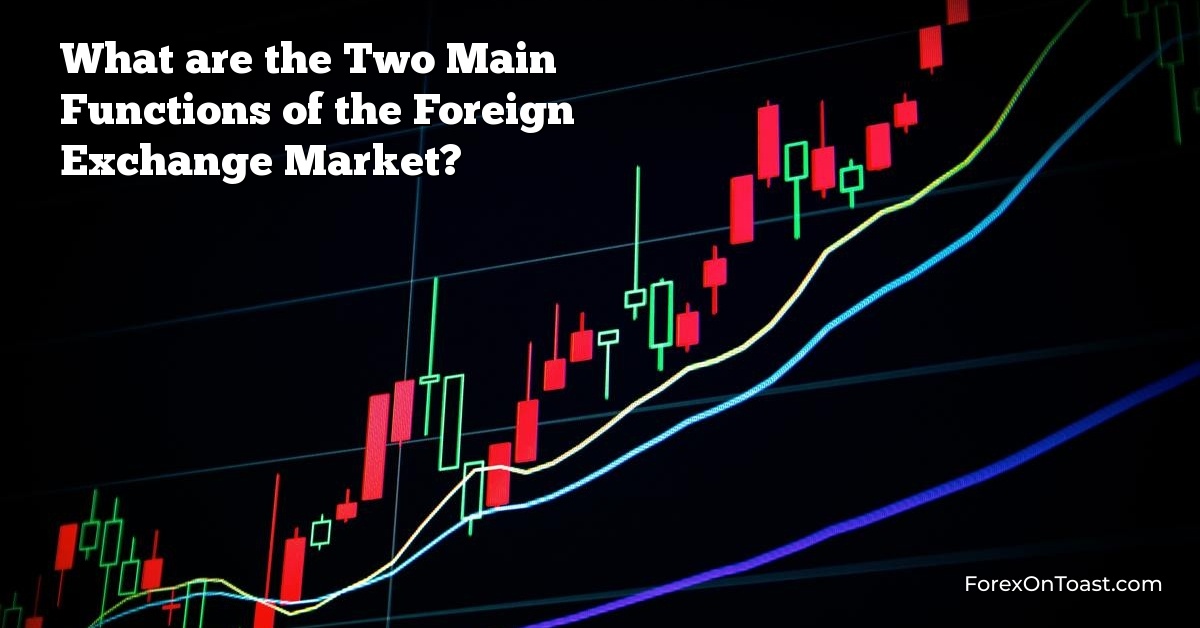The foreign exchange market is a global marketplace where millions of traders buy and sell currencies. People use the exchange market to hedge against exchange rate risks or speculate on future exchange rate movements. In this post, we’ll explain the two main functions of the foreign exchange market.
What is Forex Trading?
Forex trading is when a trader buys a currency and sells a different one, and the exchange range fluctuates according to the demand and supply. The trade for currencies takes place in the foreign exchange market that is open from Monday to Friday.
The Foreign exchange market is open 24 hours a day. All currencies are traded over the counter (OTC), which means there are no physical exchanges, and a worldwide network of financial institutions and banks oversee the operations. As a result, the vast majority of trading in the market is between institutional traders.
Two Main Functions of the Forex Market
Transfer Function
The most basic function of the Forex market is to facilitate currency conversion and also to aid countries in transferring purchasing power. However, different telegraphic transfers, credit instruments, foreign bills, and bank drafts can impact this transfer of purchasing power.
In performing this crucial function, the Forex market carries out payments globally by clearing analogous and domestic debts simultaneously.
Credit Function
Another important function of the Forex market is the credit function. The market provides credit nationally and internationally to promote foreign trade. When foreign bills are used as a means of international payment, a credit for up to three months, till maturity, is needed.
Different Ways of Trading Forex
There are three ways to trade Forex:
- Spot Market: This is the primary market for trading forex; here, pairings of currencies are swapped, and the exchange rate is determined based on demand and supply.
- Forward Market: Instead of initiating a trade, traders can have a binding contract with another trader in the forward market. The two parties will also decide the exchange rate, amount of currency, and a future date.
- Futures Market: Like the forward market, traders can opt for a contract to sell or buy a fixed amount of the currency at a specific exchange rate in the futures market.
The Risks of Forex Trading
Forex traders require leverage, and traders will also use margin, so there are risks involved. Currency prices fluctuate but not by a huge margin, so traders often need leverage to execute a trade. If the trader makes a winning bet, the leverage can help maximize the profits.
However, the leverage can also increase the losses. If the value of a specific currency falls significantly, traders that rely on leverage open themselves up to margin calls, which can force them to sell off their securities. Other than losses, transaction costs can also reduce the profit.
To become a successful Forex trader, you need to be skilled and extremely sharp, as there are many obstacles, and the risk of fraud and misinformation is high.
What Moves the Forex Market?
Like other marketplaces, the price of the currencies is determined by their supply and demand. However, other factors in the forex market need to be considered. For example, sometimes, demand for a certain currency can be influenced by the political climate of the country, economic growth, and interest rates.
The Forex market is open 24 hours and five days a week (Monday to Friday), which allows the traders to be flexible and react to changes abruptly. However, since currency trading is based on speculations, traders need to remain sharp.
Forex Day Trading
Forex day trading is a trading strategy for the short-term, and its main purpose is to buy and sell currency pairings on the same trading day. Usually, Forex traders place numerous trades a day, and by the end of the day, close them out and rarely hold positions overnight.
The price of currency pairings fluctuates, and this provides opportunities for day traders, as they are constantly looking for volatile pairings and have high liquidity. Forex day trading can generate results abruptly and is a quick way of seeing returns on investment.
The day trading is for those traders that have time to analyze trading information throughout the day. However, day trading also requires reactions to short-term changes and fluctuations in the prices of currency pairings. Therefore, traders will need to be disciplined and knowledgeable.
Conclusion
The Forex market has several functions that it needs to fulfill; however, in this article, we have discussed the two main functions of the Forex market and how other factors impact them. In addition, we have also shed led on other key aspects of the Forex market and the risks associated with Forex trading.
